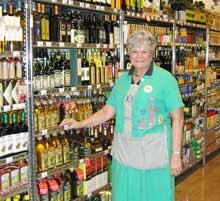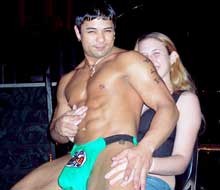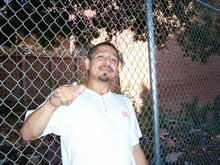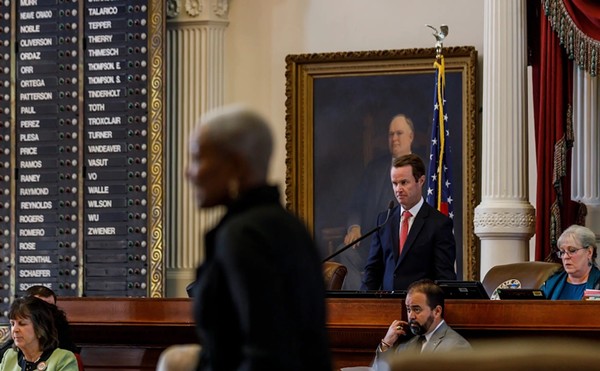Ready to ditch your Dilbert-esque grind? Meet five people who haven't seen a cubicle in years
Considering Americans spend about a quarter of their adult lives working, they sure hate their jobs. According to a recent Harris interactive survey, less than half of those polled said they were satisfied or extremely satisfied with their work; 33 percent believed they had reached a dead end; and 21 percent were eager to change careers. And all of those polled apparently steal company time to answer online surveys.
|
Featured stories Queen of the aisles To be a fly, or a deer, on the wall Everything off but the loincloth Necessity gives birth to day labor Declaring moral bankruptcy What do San Antonians earn? |
Sixty-hour work weeks, dehumanizing cubicles, cutthroat corporate culture, passive-aggressive co-workers who steal your lunch from the fridge: Those are the highlights of the modern workplace. And in some occupations, the Bush administration has ensured you don't even earn overtime pay for the misery.
This Labor Day we rounded up members of the 20 percent of Americans who still feel passionate about their jobs. Taxidermist, strip-o-gram dancer, foodie, day laborer, and artist: They aren't getting rich, but they're not, that we know of, passing out on the couch with a bottle of Jose Cuervo each night after work, either.
Now then, get your ass back to work.
Queen of the aisles
| Looking for a Postel cheese from Belgium? Bulk quinoa? Foodie Lilo Strait can find your ingredients and tell you the tastiest way to prepare them. (Photo by Susan Pagani) |
Lilo has been a foodie for eight years. The ever-shifting aisles of Central Market are as familiar to her as her own kitchen. She'll tell you not only where the late-harvest reisling vinegar is, but also that it would be delightful in a beet salad. In all her years, has anyone ever asked for something she couldn't find? "To be honest, I have to say no," she replies.
Although she has lived in San Antonio since 1965, Lilo's badge reads "Neu-Ulm, Germany," and, when she really gets talking, you can hear traces of an accent, here and there a "so" pronounced "zo." Neu-Ulm is a suburb of Ulm, an old Roman city on the banks of the Danube River and the birthplace of spätzle, but Lilo's love of food began with Christmas cookies.
In the German Christmas tradition, the Christ Child flies through the window in the form of an angel to deliver gifts and treats as children sleep. After Lilo went to bed, her grandmother would bake butter cookies, anise drops, springerle, and lebkuchen, so that each morning during the holidays, Lilo would wake to a small plate of cookies.
Cooking and entertaining have always been Lilo's hobby.
So, when the ophthalmologist she worked for retired and Lilo found herself at loose ends, her children suggested a career change.
As foodie, Lilo works 40 hours a week, "doing whatever is needed." Each month she teaches a cooking or baking class at the cooking school. Her speciality is German food, of course, and her Christmas stollen recipe is a Central Market staple during the holidays. She also writes recipes and used to cook at the sample stations, but she "curtailed that to be more available on the floor," where she feels her talents are best used.
Lilo's job requires a broad knowledge of food and wine, but she loves it when someone tells her something she doesn't know. "Recently, Jason Dady introduced me to an Italian grain: farroto. It's a pearl, like Israeli cous cous. We don't carry it, unfortunately, and you really can't find it."
Lilo once discovered me mid-reverie in front of the olive display. "Are you OK?" she asked, with genuine concern. I was, and after a good laugh, we each went our merry way, but now when I see Lilo she gives me a hug, pressing her perfumed cheek against mine and pulling me close as we stroll through the store.
I'm not special. If you linger around Lilo long enough, you will see a succession of regulars dart up to her: Lilo, I need you. One woman arrived with a calendar and a handmade book of recipes; she and Lilo had an appointment to plan a dinner party. "After eight years, I have regular customers who have established a trust in me, I suppose, to advise them in cooking and entertaining," she says. "And, of course, there's this young lawyer who just swears he is going to find a good question for me, a real stumper." •
To be a fly, or a deer, on the wall
| You stuff Thanksgiving turkeys; you mount deer. Don't confuse the two, says taxidermist Michael Botello. (Photo by Michael Cary) |
So says Michael Botello, a Harlandale High School graduate who has made taxidermy his only career. He runs Botello's Taxidermy Studio, an air-conditioned space in his garage on Huebner Road.
The proper term for preserving deer, antelope, auodad sheep, bobcats, wild boar, wild turkeys, largemouth bass, and other prized trophies is to "mount" them, which is what Botello does for his clientele, 80 percent of whom are repeat customers.
Botello learned taxidermy as a hobby when he was 12. "I always was good at art. I enrolled in a correspondence course, and learned it by mail. My first project was a dove," he says.
Last week Botello had finished arranging the feathers of a wild turkey, and was waiting for a deer hide to dry so he could finish mounting a 10-point buck. Carefully fit in a set of rubber teeth, a tongue, and a pair of glass eyes, and voila, a mounted trophy is ready for the mantle over the fireplace.
Taxidermy requires no license other than a state sales tax permit, although you need a permit from the federal government before mounting migratory birds.
Botello has had a few apprentices who thought they wanted to work in taxidermy, but "some of them work a week and quit.
"You really have to be dedicated and have an artistic ability," says Botello. "I could draw and paint when I was a kid. You have to have the talent. That's the problem with some of the other taxidermists in town; you get what you pay for."
Botello charges from $400 to $500 to mount a deer; about $600 for a turkey, $550 for a bobcat, and if you deliver a moose to his house, he'll charge you $1,500 to mount it, not stuff it. "I'm always correcting people about that."
The most unusual animal Botello has mounted was a monkey. He shies away from family pets because it's too hard to capture a facial expression that reflects the animal's personality. Wild game, on the other hand, were not intimate with the hunter before the fatal shot. Also, with pets, he says, "you don't know what they died from."
And, no, you can't get Grandma mounted, Botello says. That would be "highly illegal." •
Everything off but the loincloth
| Is that your pet python or are you just happy to see me? Cherokee the exotic dancer says he wants to make the profession respectable. (Photo by Michael Cary) |
Cherokee works with the Strip A Dancer agency, which sends male and female dancers to parties to surprise a birthday girl, or boy, with a strip-o-gram. Cherokee and other dancers dress as nurses, firemen, cowboys, even Barney or Winnie the Pooh.
"The most popular is a policeman, who will show up at a house, take a woman, sit her in the chair and say 'we can take you downtown for questioning' ... then turns on the music and strips," explains Kenny Lee, proprietor of Strip A Dancer, who also contracts his dancers to perform Wednesday through Sunday at Hardbodies on North St. Mary's. "You name it, we've done it."
Economics brought Cherokee (his stage name) to San Antonio from Hawaii, where it was expensive to live. In 1994, he moved here, where his mother lived at the time. That year, Cherokee entered an amateur dance contest at the Bonham Exchange, and someone suggested he audition at the Wild Zebra Gentlemen's Club. "I worked two weeks, quit, and went back six months later. I've been doing it ever since."
When Cherokee entered the exotic dancing world, it was dominated by 6-foot, 200-pound male dancers. "Those guys did a lot of drugs and were drunk all the time; they were nuts. They would put their heads through the wall and everything."
Cherokee, who collects Samurai swords and earned a master level in the craft when he was a kid, says he had to figure out how to make his 120-pound frame stand out among the giants. "Every year I competed it would get harder. Every year I had to come up with new routines."
The strategy worked for Cherokee, who has won nine strip-off championships in Dallas and San Antonio. "I used choreography, props and backdrops, similar to a Chippendale or a Vegas-style show," says Cherokee, who also has produced a rap CD, Cherokee the Dragon.
One of Cherokee's acts includes smoke and pyrotechnics, in which he steps from a cloud of smoke dressed as a Hawaiian prince wearing a grass skirt and chachayotes. In another, Cherokee dresses like a pharaoh or a lighted mummy.
He keeps a Winnie the Pooh and a Tigger costume, and he uses those characters to entertain at children's birthday parties. He does not strip in front of children.
"I wanted to clean up the exotic male dancer business," Cherokee says. "I knew the only way to make it more respectable was to clean it up. It's hard not to fall to temptation, because there's lots of women, drugs, and alcohol, and you can easily fall into that. In the 11 years I've been doing this, I've never slept with a customer." •
Necessity gives birth to day labor
| San Ramon is one of at least a dozen day-laborers who gather every morning near the corner of Houston and Frio. (Photo by Gilbert Garcia) |
"It's under the table, straight-up cash," says Daniel, 38, a soft-spoken man with long black hair and a thick beard. "I came out here because they pay better than a lot of these labor hauls. They're taking all your cash and you're getting $5 or $6 an hour. Out here you can make your eight bucks."
Daniel, who describes furniture moving as his true forte, says he inadvertently stumbled into day labor five months ago after being sentenced to community service at the nearby SAMM Shelter for a series of outstanding traffic citations. "I was hanging out at the corner," he says. "This guy came by and offered to have me do a roof for him. He told me, 'I'll give you $120.' So I took it."
Like many of his cohorts, Daniel catches a bus from the South Side around 5 a.m. every day and arrives at the Houston-Frio gathering point by 6 a.m. It's not unusual for these workers to spend hours waiting for a landscaping or construction gig, but they've learned the art of patience. "Out of nowhere a guy will drive by and say, 'I need four or five guys,'" says San Ramon, 31, a self-described jack-of-all-trades who's been coming to this spot for two years. "Half of us will go and the rest of us will have to wait a few more hours. It gets really rough."
"Sometimes you get weekly work and sometimes daily," Daniel adds. "You're taking a shot just like the lottery. You get lucky one day but you might not the other day."
Both men say the biggest downside to their labor freelancing is the grief they get from some patrolling police officers. "The police come out here and they run people off," Daniel says. "Some of them are real cool, they understand that everybody's out here trying to make a buck. And some of them are real rude and thinking that you're bothering people."
If police officers make that assumption, it's because part of the process involves waving down passing drivers and racing to any car that stops on this block. It's a process that creates an inevitable contradiction. These workers spend hours together every morning forming a brotherly bond, but when a job presents itself, they'll ruthlessly race each other to the potential employer.
"It's like a rat race out here," San Ramon says. "There's too many of us out here and not enough work. You just have to be real fast. But we're real tight right. This is a family." •
Declaring moral bankruptcy
| Looking for Enron: Russian-born artist Anton Vidokle's 100 Bankrupt Corporations. (courtesy photo) |
The 100 Bankrupt Corporations ...
Look, this is a bit if a joke. It was really hot and I was working, and they called me up from Artpace and said, What's the title of this work? I was in a really bad mood for a second, so I said, "100 Bankrupt Corporations."
Artpace really ran with that idea.
The real title of this whole series of work is Popular Geometry. That's a bit of an oxymoron because geometry's ultimately very unpopular. People hate geometric abstract sculpture.
It maybe has to do with a reaction to that great '70s modernism, which was really tied in very closely to much larger social processes in many countries. Here it was very much a transition from a progressively based society to these neo-liberalism, neo-conservative movements. The political and economic change was also accompanied by a change in architectural styles and graphic designs.
How long have you been a professional artist?
It depends what you mean by professional. There is a report by the Rand Corporation; they looked into the contemporary-art situation because there's been this appearance of a vast boom where artists are becoming rich and famous and make millions of dollars from resale of artwork. What Rand is saying is, yeah, there's maybe a handful of artists who make quite a bit of money, but 99 percent of what you would call professional artists support themselves by doing something else.
In your travels, have you visited other countries where you thought, This seems like a great place to be an artist right now?
Anywhere in the Middle East right now is really interesting in the sense that, although they don't have a market, and they don't have museums of contemporary or modern art - what they do have, which is something that is really lacking in Europe and North America, is a sense of actually having some kind of an impact on culture, and not marginal impact, not this sort of glorified decorator, but something that is quite serious.
The fact that we focus on the money, doesn't that exacerbate the problem of art becoming glorified interior decorating?
Cultural value and economic value, people don't see the separation anymore, which I think is a terrible thing. It's a distortion of reality.
If there was one ideal that you could reclaim from the '70s, what would it be?
Ooph. That's such a complicated question. It's very hard to say because I was not really an adult in the '70s, so I'm not really dealing with memory, I'm dealing with some kind of mythology. Maybe there was a greater sense of social cohesion that could be important to reclaim again, where society is not so purely individualistic. •
| How much do San Antonians earn? | ||
Average hourly wage | San Antonio | Dallas |
| All part-time and full-time workers: | $15.76 | $20.22 |
| Private industry, p-t/f-t: | $14.53 | $19.78 |
| State and local government, p-t/f-t: | $19.44 | $22.74 |
| Union jobs: | $19.58 | $21.72 |
| Non-union | $15.34 | $20.08 |
| Full-time | $16.74 | $20.95 |
| Part-time: | $8.15 | $10.46 |
Average hourly wage, by occupation | San Antonio | Dallas |
| Financial managers: | $38.62 | $57.13 |
| Executive, administrative, managerial: | $37.08 | $34.09 |
| Secondary school teachers: | $28.73 | $29.50 |
| Computer systems analysts and scientists: | $28.63 | $33.83 |
| Elementary school teachers: | $27.75 | $28.49 |
| Registered nurses: | $24.50 | $25.26 |
| Police and detectives: | $21.15 | $23.74 |
| Firefighters: | $17.81 | $19.46 |
| Licensed practical nurses: | $15.09 | $18.35 |
| Transportation and material moving: | $14.14 | $15.98 |
| Social workers: | $14.03 | $18.81 |
| Sales: | $13.47 | $17.70 |
| Secretaries: | $13.01 | $17.48 |
| Machine operators, assemblers, and inspectors: | $11.52 | $13.15 |
| Bus drivers: | $10.86 | $13.95 |
| General office clerks: | $10.45 | $13.62 |
| Janitors: | $8.79 | $9.19 |
| Cooks: | $8.32 | $8.58 |
| Maids: | $8.31 | $7.04 |
| Waiters, waitresses, and bartenders: | $3.73* | $4.74* |
*Doesn't include tips | ||
Source: Bureau of Labor Statistics survey of 263,600 area workers, November 2004 and 1,140,300 Dallas area workers, March 2004 (latest figures available) | ||























